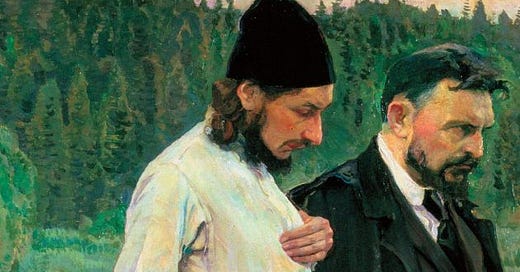Ice, Fire, and Mystery: The Paradox of Faith in the Life of Pavel Florensky
How one man defied the Gulag with wonder
In the Soviet Union, religion was commonly viewed as a crutch. We were taught to believe that those who held religious faith couldn’t handle life on their own and needed some form of external support. If you are strong, you don’t need faith.
Surprisingly, this view was often shared even by believers. And yet, it didn’t align very well with those who didn’t fit the mold. For some, faith was clearly not a crutch—not something that merely helps you survive, but something that makes you thrive.
Crutches can’t make anyone thrive; at best, they can help you get by. Faith used as a crutch is not true faith. True faith is the source of overflowing life—even more so in the face of insurmountable odds.
Pavel Florensky, a Russian Orthodox priest refused to renounce his priesthood and was sentenced by the Bolsheviks to a term in the Gulag in the Far East. His wife and five children remained in Moscow. He knew that his ideological and philosophical clash with communists could cost him his life—but it didn’t dampen his spirit.
He understood that the mystery of life was far greater than life itself—even in the Far East. So, the first thing he did there was begin studying permafrost. Four months into his term, he wrote to his son about the mysterious beauty of “ice caves”:
“What resulted were fairytale-like caves made of the purest crystal ice—radiant ice, fibrous ice, white ice, and at the bottom, reddish-brown, yet completely transparent… I don’t have the ability to describe how beautiful it is, nor can I draw it. One day, you’ll see a series of sketches of the columns and other details, but even those sketches don’t come close to conveying the beauty of these caves. I doubt that any artist could truly capture it—it’s too difficult a task. It’s better to read fairy tales.”
So, he created a lab to study the beauty of permafrost. Later, he discovered a nearby nomadic tribe—the Oroch—that didn’t have a written language but had a rich oral tradition and their own spoken tongue. He began studying their language, eventually devised an alphabet for them, and recorded their epic stories. This led to the idea of establishing a museum in the area, dedicated to their nomadic culture and legacy.
Somehow, in his mind the mystery of ice was intertwined with the mystery of the Oroch people. He was so passionate about this work that he invited his wife and children to come live in a nearby settlement so they could see each other. And they came. But their happiness was short-lived—Florensky was soon transferred to the Solovki prison camp in the Onega Bay of the White Sea.
Someone in power must have discovered what he had been doing. They thought hard labor would break him. It didn’t. So they transferred him to a special camp called Elephant (СЛОН), where inmates rarely survived. Florensky realized this would likely be the end. So what did he do?
One day, while being marched along the shore of the White Sea, he noticed large amounts of algae covering the beach. When they brought him back to the camp, he proposed the idea of building a plant to extract iodine from the algae.
Surprisingly, the authorities liked the idea and built the plant. According to some accounts, it became the largest iodine supplier for the Soviet front during World War II. And it is still in operation to this day.
His whole life was a pursuit of Mystery.* He searched for it everywhere—and it infused him with meaning and life. Everyone who knew him was struck by the overflow of life he radiated, even in the face of death. He was executed in 1937, and no one knows where he is buried. But everyone who knew him said the same thing: this man was truly alive.
A crutch can’t give life. Faith can. People don’t need a CPR—they need meaning.
“Those who have a ‘why’ to live, can bear with almost any ‘how’.” Viktor Frankl
* The book Naming Infinity (2009) tells the story of a group of early 20th-century Russian mathematicians—especially Dmitri Egorov, Nikolai Luzin, and Pavel Florensky—who were influenced by a mystical religious practice called Name Worshipping. This practice was based on the belief that the name of God is deeply connected to God’s presence.
These mathematicians believed that naming something—like infinity—was a way of making it real, not just symbolically but spiritually. Their understanding of mystery, imagination, and mathematics allowed them to make groundbreaking advances in set theory. Their colleagues in France, who followed a strict form of rationalism, suffered a mental breakdown after realizing that the paradoxes of infinity could not be solved with the mind.





We in the West don’t even realize just how much we have been infected by the Post-Enlightenment obsession with data and facts, as if scientism and materialism create the best informed thinkers and that that is the ultimate goal of life. In CS Lewis’ Discarded Image he was trying to help us understand that we believe we disproved the Medieval models because they were wrong, but he argued that we simply discarded them because we no longer found them useful. The Medieval mind with it’s systematic approach prized significance. We threw away meaning because we found the truth. Meaning is not expressed in facts. The truth is certainly a worthy goal, but it does not account for mystery and enchantment. The Church in the East has been faithful to the idea of faith as mystery. We in the West could certainly learn from them to appreciate mystery and enchantment.
This was fantastic. Too short for my liking:) I’d love to hear more about Pavel Florensky. He is an unknown spiritual giant in my heart. A hidden life! Thank you.